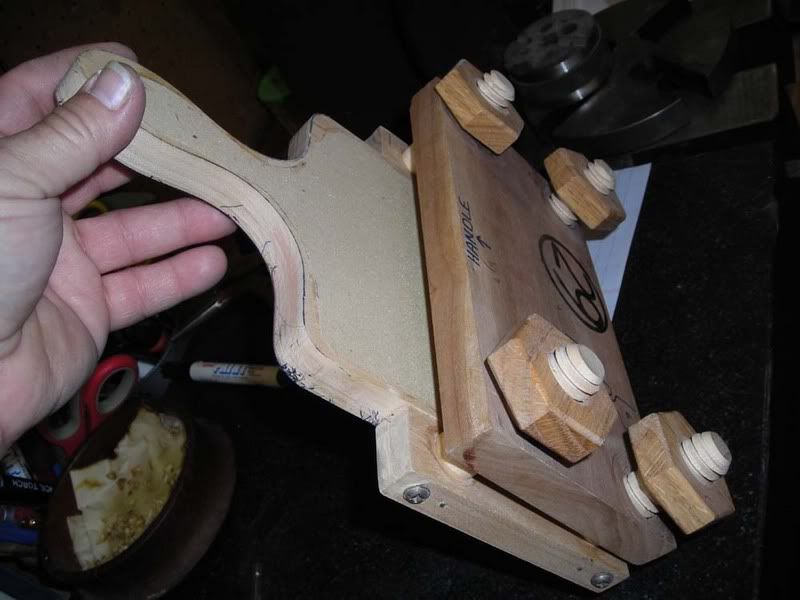When a log is too small for a CS mill, and I don't have a Band Saw (BS)at home (I do have access at work but BS mods/rigs/jigs are not permitted) one can rig up something like this attached to a Table Saw (TS). This rig is also adaptable to a BS if I ever get around to creating enough space in my shed OR getting a bigger shed so I can house one.

The rig is made from 3 pieces of angle iron and a 40" long piece of c-setion. Th rig rides in (or attaches to) the saw table via the TS table track. The two bits of angle iron front and very back are bolted to the c-section at the LHS. The log is gripped by the middle and front bits of angle. The middle piece of angle can slide back and forth along the c-section using wing nuts on the all thread rods which provides a double clamping action on the log. The amount of leverage possible with the double clamp is high ensuring the log stays in place during the sawing process. For extra grip pointed bolts that can be scewed into the log are available front and back but these are only required if the ends of the log are not very square.

The rig is really only used to produce one cut (a flat face ) or two right angled faces. Then the log is transfered to a jointer where the right angled is trued up and then it's back to the TS (sans rig) for cutting up against a conventional TS fence. A big advantage of this rig is that the log can be sawn off centre providing access to the true quarter saw portion of a log. Of centre cuts on logs are both difficult and very dangerous on a TS without a rig like this. The diameter of the log one can tackle is nominally dependent on the max cutting depth of the TS (mine is 4") but turning the log over one can get twice that. Although the rig can hold a 36" long log, the maximum length I can do at the moment is limited by the way the rig attaches to the track (in just 2 places) to about 12". I am going to change this to a full length t-track holder and this will enable me to extend the length to about 25" - my main limitation will then be the size of my shed. Once could use in-out feed rollers if one had the space to use the full 36" of the rig.
When not in use the rig tucks away nicely under my TS.

BTW the wood is Western Australian Jam (Acacia acuminata) and does not grow much bigger in the trunk than what you see here.

This wood has a density of 1171 kg/m^3 or 73.1 lbs/.ft^3 and is extremely hard and very difficult to cut. When you cut it is smells like raspberry Jam hence its name. The wood is termite resistant and is used mainly for fencing but as you can see it looks really nice.
The rig is made from 3 pieces of angle iron and a 40" long piece of c-setion. Th rig rides in (or attaches to) the saw table via the TS table track. The two bits of angle iron front and very back are bolted to the c-section at the LHS. The log is gripped by the middle and front bits of angle. The middle piece of angle can slide back and forth along the c-section using wing nuts on the all thread rods which provides a double clamping action on the log. The amount of leverage possible with the double clamp is high ensuring the log stays in place during the sawing process. For extra grip pointed bolts that can be scewed into the log are available front and back but these are only required if the ends of the log are not very square.
The rig is really only used to produce one cut (a flat face ) or two right angled faces. Then the log is transfered to a jointer where the right angled is trued up and then it's back to the TS (sans rig) for cutting up against a conventional TS fence. A big advantage of this rig is that the log can be sawn off centre providing access to the true quarter saw portion of a log. Of centre cuts on logs are both difficult and very dangerous on a TS without a rig like this. The diameter of the log one can tackle is nominally dependent on the max cutting depth of the TS (mine is 4") but turning the log over one can get twice that. Although the rig can hold a 36" long log, the maximum length I can do at the moment is limited by the way the rig attaches to the track (in just 2 places) to about 12". I am going to change this to a full length t-track holder and this will enable me to extend the length to about 25" - my main limitation will then be the size of my shed. Once could use in-out feed rollers if one had the space to use the full 36" of the rig.
When not in use the rig tucks away nicely under my TS.
BTW the wood is Western Australian Jam (Acacia acuminata) and does not grow much bigger in the trunk than what you see here.
This wood has a density of 1171 kg/m^3 or 73.1 lbs/.ft^3 and is extremely hard and very difficult to cut. When you cut it is smells like raspberry Jam hence its name. The wood is termite resistant and is used mainly for fencing but as you can see it looks really nice.
Last edited:








